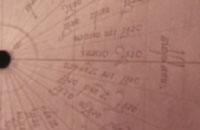Islamic astrolabes and the weather
The Arab theory of winds centred on four cardinal winds and is recorded mainly in folk-astronomical texts, suggesting that it was an old and established tradition. The four cardinal wind directions were astronomically defined: the qabûl was defined as being from the direction of the summer sunrise, and the janûb as being in the direction of the rising of the star canopus. These four cardinal winds are roughly perpendicular but are not equivalent to north, south, east and west: they are offset by about 25°. David King has suggested that the sacred Ka'ba in Mecca is oriented according to these four cardinal winds, an association found in several medieval Islamic texts. In addition, Arabic folklore associates the sides of the Ka'ba with winds and rain. Some astrolabes include plates with markings related to this wind theory, indicating the importance of the instrument as a way of calculating the directions of the winds and possibly therefore calculating the orientation of the Ka'ba.
Recommended Reading
Sarah Schechener Genuth "Astrolabes: a Cross-Cultural and Social Perspective" introduction to Webster (ed)
Western Astrolabes
David King Astronomy in the Service of Islam 1993
John North, The Fontana History of Astronomy and Cosmology, London 1994
Full Bibliography
 Detail of the wind rose in a western universal astrolabe in the Whipple Collection. (The larger images show the whole thing.)
Detail of the wind rose in a western universal astrolabe in the Whipple Collection. (The larger images show the whole thing.)
 Detail of the wind rose in a western universal astrolabe in the Whipple Collection. (The larger images show the whole thing.)
Detail of the wind rose in a western universal astrolabe in the Whipple Collection. (The larger images show the whole thing.)